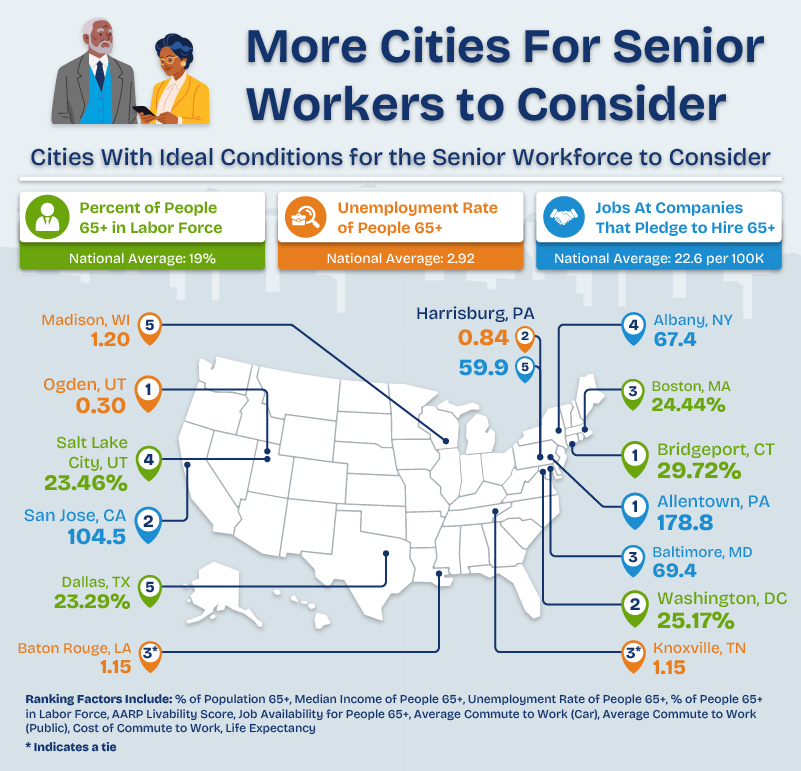As more people face the reality of working into their 60s and 70s, many older Americans are not choosing to work longer but are doing so out of necessity. This encouraged us to take a look at parts of the country that are best set up for the 65+ workforce.
We’ll explore the top cities where older Americans can thrive in their careers based on various factors like labor force populations, income levels, unemployment rates, and job availability for those 65 and older. By analyzing city-level data, we’ve determined which cities offer the best opportunities and environments for older workers.
Understanding where these cities stand can help older Americans make informed decisions about their work and retirement plans. Dive into our findings to see where your city ranks and what makes certain locations stand out for the 65+ workforce.
The Best and Worst U.S. Cities for Older Workers
Let’s take a look at the parts of the country that best set the 65+ workforce up for success. We analyzed ten different local data points to determine which cities across the U.S. are most and least accommodating for older workers.
The Best Cities for the 65+ Workforce
-
- Madison, WI – Score: 70.61 out of 100
- 65+ unemployment rate: 1.2% (59% lower than average)
- AARP livability score: 67 (best in the study)
- Average commute to work by car: 22 minutes (14% faster than average)
- Durham, NC – Score: 67.12
- Job availability: 52 jobs per 100K people 65+ (7th most in the study)
- Average cost of work commute: $6.12 (21% lower than average)
- 65+ labor force: 22% (3% higher than average)
- San Jose, CA – Score: 66.09
- Median income of 65+ population: $88,393 (56% higher than average)
- 65+ unemployment rate: 2.3% (22% lower than average)
- Life expectancy: 84.1 years (highest in the study)
- Madison, WI – Score: 70.61 out of 100
These cities, while geographically diverse, share some common features that make them ideal for the 65+ workforce. Madison, for instance, boasts the highest AARP livability score. Durham offers a robust job market for the 65+ labor force while San Jose stands out with the highest median income for older Americans.
The Worst Cities for the 65+ Workforce
-
- Stockton, CA – Score: 28.37 out of 100
- 65+ population: 13.5% (21% lower than average)
- AARP livability score: 47 (6th worst in the study)
- Average commute to work by car: 33 minutes (28% lower than average)
- Lakeland, FL – Score: 28.39
- Median income of 65+ population: $46,961 (17% lower than average)
- Estimated cost of work commute: $10.17 (31% higher than average)
- 65+ labor force: 14.9% (22% lower than average)
- Riverside, CA – Score: 31.80
- Job availability: 10.4 jobs per 100K people 65+ (54% lower than average)
- 65+ unemployment rate: 5.7% (94% higher than average)
- 65+ population: 14% (18% lower than average)
- Stockton, CA – Score: 28.37 out of 100
Regional trends emerge more clearly among the least-accommodating cities for an older labor force. Three of the bottom five cities in our index are in California. Additionally, three Texas cities and two Florida cities rank in the bottom 10.
These metro areas generally have lower populations of older working Americans and aren’t as well-suited for this demographic. For example, Stockton has one of the lowest AARP livability scores. Lakeland has a lower-than-average median income for people 65+ and higher estimated work commute costs. Riverside is notable for its high unemployment rate among the 65+ population and significantly fewer job opportunities for older Americans.
Other Great Cities for Older Americans to Work
Next, we’ll explore some of the cities that excel in key factors that older workers might consider when looking for somewhere to live. We’ll focus on the cities with the largest 65+ labor forces, the lowest unemployment rates for people 65+, and the highest availability of jobs for older Americans.
The national averages for these data points are:
- Percent of 65+ Population in the Labor Force: 19%
- Unemployment Rate of 65+ Population: 2.9%
- Percent of Population 65+: 17%
Cities with the Largest 65+ Labor Forces
- Bridgeport, CT: 29.7%
- Washington, DC: 25.2%
- Boston, MA: 24.4%
- Salt Lake City, UT: 23.5%
- Dallas, TX: 23.3%
Cities with the Lowest Unemployment Rates for People 65+
- Ogden, UT: 0.3%
- Harrisburg, PA: 0.84%
- Baton Rouge, LA: 1.15%
- Knoxville, TN: 1.15%
- Madison, WI: 1.2%
Cities with the Most Available Jobs from Companies that Hire Older Americans
- Allentown, PA: 178.8 jobs per 100K people 65+
- San Jose, CA: 104.5 jobs per 100K people 65+
- Baltimore, MD: 69.4 jobs per 100K people 65+
- Albany, NY: 67.4 jobs per 100K people 65+
- Harrisburg, PA: 59.9 jobs per 100K people 65+
While many of these cities did not top our overall list, they are still excellent options for older working Americans. Cities with larger older labor forces, like Bridgeport, Boston, and Salt Lake City, are well-suited for this demographic. These cities are more accustomed to having older workers, indicating a supportive environment for this population.
Additionally, cities with low unemployment rates, such as Ogden, Harrisburg, and Baton Rouge, show a commitment to their older workforce, with very few older people struggling to find work. On the topic of job availability, cities like Allentown, San Jose, and Baltimore offer the best access to jobs from companies that prioritize hiring older workers.
Where Does Your City Stack Up For Older Working Americans?
Wondering how your city ranks for older working Americans? We’ve put our data into an interactive table where you can explore the factors we considered when putting this ranking together.
You can search for your city by name, sort by each column heading, or browse our compilation of data to see where your city lands in our ranking.
Closing Thoughts
As we’ve explored the landscape for older working Americans, it’s clear that some cities are better suited to accommodate the 65+ workforce than others. Factors like job availability, unemployment rates, and livability metrics are things older people should consider when finding the right spot to continue their careers.
Social security and retirement savings aren’t going quite as far as they used to, so needing to work later in life has become a reality for many Americans.
That’s where Coventry Direct comes in. Visit our website today to see if you qualify to sell your life insurance policy.
Methodology
To identify the best cities for workers who are 65 and older, we evaluated the 100 most populous U.S. metro areas on 10 different criteria that would most impact older Americans who are still working.
All the factors were weighted based on their importance to working people 65 and older. The individual factors were given scores from 0 to 5 and summed to reach a total score of 0 to 100 with 100 representing the cities that are best suited to give the 65+ workforce a good life.
For a full list of factors we considered, as well as their sources, see the table below.
| Ranking Factor | Source |
|---|---|
| Population 65+ | U.S. Census |
| Median Income of People 65+ | U.S. Census |
| Unemployment Rate of 65+ | U.S. Census |
| 65+ Labor Force | U.S. Census |
| Livability Score | AARP |
| 65+ Job Availability | AARP |
| Average Commute to Work (Car) | U.S. Census |
| Average Commute to Work (Public) | U.S. Census |
| Cost of Commute to Work | AAA, StreetLight Data, EPA, Experian |
| Life Expectancy | County Health Rankings |




